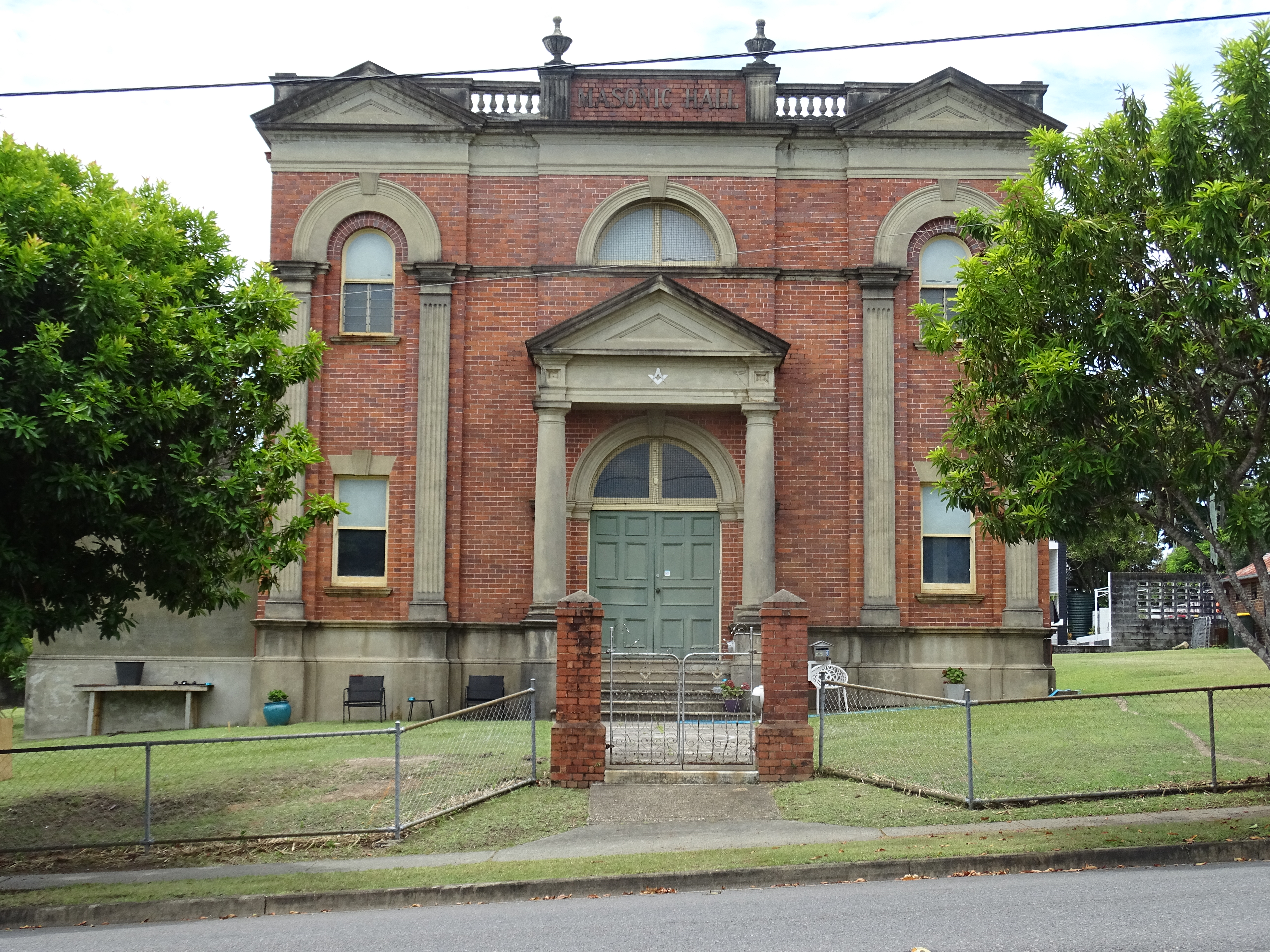Address summary
5-7 Tingal Road, Wynnum, QLD 4178
Addresses
Type of place
Hall
Period
Interwar 1919-1939
Style
Georgian Revival
Address summary
5-7 Tingal Road, Wynnum, QLD 4178
Addresses
Type of place
Hall
Period
Interwar 1919-1939
Style
Georgian Revival
This Masonic Hall was designed and constructed in 1920 by Veritable Worship Brother F.J. Wilkes, who was himself a Freemason. The Wynnum Lodge was originally formed in 1894 but it was not until 1919 that its members decided to build their own meeting hall. For more than 100 years now, the Georgian Revival style hall has provided a place for Lodge members to meet, organise charitable activities and hold social events, and has become a landmark in the Wynnum area.
Lot plan
L509_RP33003; L510_RP33003; L511_RP33003; L508_RP33003
Key dates
Local Heritage Place Since —
Date of Citation —
Construction
Roof: Corrugated iron;Walls: Face brick
People/associations
F.J. Wilkes (Architect);F.J. Wilkes (Builder)
Criterion for listing
(D) Representative; (E) Aesthetic; (H) Historical associationInteractive mapping
Lot plan
L509_RP33003; L510_RP33003; L511_RP33003; L508_RP33003
Key dates
Local Heritage Place Since —
Date of Citation —
Construction
Roof: Corrugated iron;Walls: Face brick
People/associations
F.J. Wilkes (Architect);F.J. Wilkes (Builder)
Criterion for listing
(D) Representative; (E) Aesthetic; (H) Historical associationInteractive mapping
History
A recognised international organisation of some antiquity, Freemasonry is a fraternity officially established in Queensland in 1859. According to its guidelines, Freemasonry promotes the development of personal character, supports extensive and varied charities, acknowledges a non-political but patriotic lifestyle, and allows the free expression of religious beliefs amongst its members. Traditionally the Freemasons Lodges that were formed throughout Brisbane and the state, adhered to different national constitutions, the English, Scottish and Irish, and resisted attempts to unite them in one grand Lodge.
The Wynnum Lodge was formed under the Irish Constitution in 1894 with 24 foundation members, and met for a considerable time in the Divisional Board Hall. Some original members of the Lodge included J W Wassell, RB McIntyre, Henry Randel and F H Clarke. By 1896 the lodge operated as the Wynnum Lodge No 342. Other Masonic Lodges to meet at the Divisional Board Hall (or sometimes in St. Peters Church Hall) were the Moreton Lodge (English Constitution) formed in 1913 and the Tuscan Lodge (Scottish Constitution) formed in the following year.
In 1919 a decision was made to erect a Masonic Lodge in Wynnum. In that year, title of the land passed to Henry Clarke and Arthur Dickins as trustees. A bill of mortgage for £1 500 to the Bank of New South Wales was taken out in July 1920, followed by an additional mortgage of 3 000 in December 1920. This Georgian Revival style temple was built in 1920 at a cost of 4 000. The property was again mortgaged in September 1922 for an additional 3 000. The designer and builder of the new lodge was Veritable Worship Brother F.J. Wilkes, whose photograph has remained on display in the Lodge.
The erection of the building only just preceded the creation of the United Grand Lodge of Queensland in April 1921, uniting Lodges of the various constitutions after many years of division. The Lodge at Wynnum played an important role in the community by performing charitable works and making regular donation to institutions including the Wynnum Fire and Ambulance Brigades and the Brisbane General Hospital. A widows and children’s fund was another Mason initiative at Wynnum. The charitable activities of the Masonic lodges were not, however, made public, as the Masons preferred to work quietly for the community without fanfare. The Masonic Lodges also held social events in their hall as well as in the Hemmant hall and the Wynnum School of Arts hall.
Many Masons were themselves important personalities in the local community, for example, Joe Sands, who was the Shire Clerk at Wynnum from 1907 and the District Engineer from 1925 when the various Brisbane Councils were amalgamated. Mr Sands had a long association with the Wynnum Masonic Lodge from the 1920s as a member of the St. Andrews Cross Lodge, including the positions of secretary and treasurer. Joe Sands had many other community commitments including the office of Treasurer at the Wynnum Baptist Church for some 30 years and positions on the Fire Brigade and Ambulance Boards.
In 1933 Thomas Kilby and Joe Sands joined Henry Clarke as Trustees for the property, and an additional mortgage was taken out over the property. Finally in 1958 the interest in the mortgage was transferred to the Trustees of the Grand Lodge of Ancient Free and Accepted Masons of Queensland. Title of the land is now held by the trustees of Moreton Lodge No 226.
The building continues to operate as a Masonic Lodge with 5 craft lodges using the centre as a meeting place.
Statement of significance
Relevant assessment criteria
This is a place of local heritage significance and meets one or more of the local heritage criteria under the Heritage planning scheme policy of the Brisbane City Plan 2014. It is significant because:
Citation prepared by — Brisbane City Council (page revised February 2024)

